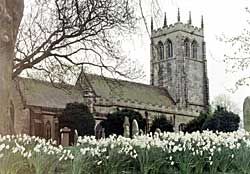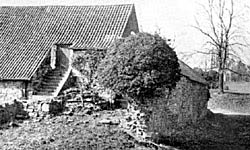
St Mary, Greasley has "a proud 15th century tower, tall and broad": the nave and chancel were rebuilt in the late 19th century. The churchyard lies adjacent to the Greasley Castle site. (A. Nicholson, © 2003).
If the services which Nicholas performed for the king were insufficient to put him in favour, he had powerful relatives to obtain for him what he required. One of these, William de la Zouch, who was constantly employed by Edward III. in various capacities, became Archbishop of York in 1342,3 and in the foundation charter of Beauvale one of the reasons given for the founding of the monastery was the desire to ensure “the good estate of Archbishop Zouch,” the founder’s “most dear lord and cousin.” The charter was witnessed at Greasley on December 9th, 1343, by many distinguished men. It was probably one of the earliest and greatest gatherings that ever took place in Greasley. In addition to the Archbishop of York were the bishops of Durham, Lincoln and Lichfield; the earls of Derby, Northampton and Huntingdon; Sir John Grey; Sir William Deincourt and Sir William de Grey of Sandiacre, knights; William, son and heir of the founder and William’s son Nicholas. Another and shorter charter was witnessed by several knights of the district.4 Altogether it was a most imposing company which took part in this house-warming at Greasley Castle, and which witnessed the Beauvale charters. The whole event was probably one of the greatest days in the life of Nicholas de Cantelupe.
It is not easy to see at first, why Nicholas chose to build his castle at Greasley. It is by no means an ideal situation from a military point of view. The castle was overlooked by the church, built higher up on the slope of the hill, and by a hill on the opposite side of the modern road from Nottingham to Alfreton. It occupied no strategic position as the castles of Nottingham and Newark did, and although there is a good view from Greasley Castle over the valley below, there is nothing like the range of view seen from Laxton Castle, to mention one. All this stresses the point already made, that defence and military strength were not the only things in the mind of its builder, when Greasley Castle was constructed. Why did not Nicholas chose Ilkeston for his fortified house? It seems to offer a better site. Close proximity to the castle of the Greys at Codnor (built 1224-58) also in Derbyshire, can scarcely have been the cause of the rejection of Ilkeston, as Greasley is nearer to Codnor than is Ilkeston. The reason seems to lie rather in the facilities which Greasley and the surrounding country offered to Nicholas in carrying out his twofold scheme of building monastery and castle after the fashion of earlier barons. At the foundation the monks of Beauvale were given the monastery that he had built “in his park of Greasley,” and a considerable amount of land in Greasley and Selston. Four years later additional grants of lands and rents were made to the value of £20 per annum in Selston, Watnall, Kimberley and Newthorpe.
The life of Nicholas de Cantelupe may be used to illustrate a number of changes which were taking place during the reign of Edward III. In the first place, the character of the baronage was changing, for not only was the number of the barons steadily diminishing, although their individual wealth and power were growing, but they had also forgotten their old desire for local independence, and had acquired an interest in national government. At the same time knights and smaller gentry were beginning their rise to power, which made them in the 18th century, in a sense, more powerful than the central government itself. Nicholas de Cantelupe, third baron, Lord of Eselburgh in Bucks., Ilkeston, Greasley and of several villages in the adjoining county of Lincolnshire, was a member of the diminishing baronage, the most distinguished representative of the Nottinghamshire branch of the Cantelupe family, a branch which died out with the deaths of the grandsons of Nicholas. Although he allowed himself the dignity of a fortified dwelling, styled castle, and founded a monastery after the fashion of the Norman barons, it would appear that most of his time was spent in the service of the king, either in administration or in war against the king's enemies.
It has already been mentioned that the Calendar of Patent Rolls of Edward III., Vols. I to X, and the Calendar of Close Rolls furnish abundant evidence of the employment of Nicholas by the king on Commissions of Oyer and Terminer. It is also clear from these records that in 1340 Nicholas was appointed to supervise in Lincolnshire, and later in Nottinghamshire, the assessment and collection of the ninth granted to the king by statute.5 The employment of men like Nicholas de Cantelupe on commissions of Oyer and Terminer and in the collection of taxes illustrates the fact that the older method of itinerant justices seems to have gone out of use in the time of Edward III.
The eyre appears to have been regarded as a sore burden on the counties, causing many complaints, and as the machinery for collecting revenue, it was becoming unnecessary, for the king was coming to depend more and more on taxes granted by Parliament, and less and less on the profits of jurisdiction, and the income derived from his feudal rights, escheats, wardships, and so forth.6
Lack of time and space prevents any attempt at an adequate treatment of the history of Greasley Castle and its owners after the death of Nicholas de Cantelupe. A brief sketch must suffice. Nicholas had a son William about whom there is little to record beyond his want of originality in calling his sons Nicholas and William.7 Eventually William and Nicholas died without issue, Greasley coming into the hands of the Zouch family, which was connected with the Cantelupes, as has already been shown.8
The Zouch family held it until, in 1485, the Battle of Bosworth brought a change of ownership. Lord Zouch took sides with Richard III. and was slain at Bosworth.9 Afterwards along with the Duke of Norfolk, the Earl of Surrey, Lord Ferrers and twenty-three knights, he was declared guilty of high treason and his property forfeit to the Crown.10 On March 7th, 1486, the castle, manor and lordship of Greasley and Kimberley, co. Notts., and the manor and lordship of Ilkeston, and a coal mine in Ilkeston were granted with other lands to John Savage the younger, Knt., “in consideration of his having largely exposed himself with a crowd of his kinsmen, servants and friends as volunteers in the king’s service in the battle against the king's great adversary Richard III., the late pretended King of England, and also in consideration of other services rendered always with anxious solicitude during prosperity as well as adversity.”11

The outbuildings at Greasley Castle Farm in the 1920s.
John Savage had not shown towards Richard III. the quality of faithfulness ascribed to him by the document quoted. He had been created Knight of the Bath by Edward IV. on April 17th, 1483, and he was one of those selected to bear Edward’s body into Westminster Abbey. In 1484-85 he was Mayor of Chester and much preferment was bestowed upon him by Richard III., but while Lord Zouch remained faithful to Richard and was slain on Bosworth Field, Savage seems to have had a secret understanding with Henry Tudor and joined him on his march through Wales. According to some authorities he commanded the left wing of the Lancastrian army at Bosworth. When Sir John Savage was killed at the siege of Boulogne in 149412 the castle and lands descended to his son John. This John Savage and his son, another John, were found guilty of the murder of one John Pauncefote, but were pardoned for their offences on the promise to pay to the king 4,000 marks. Their lands in Granby, Sutton, Greasley and Kimberley were taken over “for further surety of payment.”13 Sir John Manners, grandfather of the Earl of Rutland, who was alive when Thoroton wrote (June 16th, 1673), purchased the lordship of Greasley from the Savages,14 (probably in 1608).
No satisfactory evidence has been found that Greasley Castle was subject to any attack or siege. Baron von Hube, in his History of Greasley, p. 94, mentions a tradition that the castle was taken and overthrown during the Civil War, but until definite information is forthcoming the problem must be left open. Throsby (1797) states that “the mansion of Nicholas de Cantelupe which has been since his time called a castle, by reason he had liberty from Edward III., to fortify it, is totally destroyed except a plain wall or two.” This statement and the discovery of late 17th century pottery seems to suggest a date round about 1700 as the probable time at which Greasley was abandoned and its destruction begun.
My thanks are due to I. C. Grammer, Esq., the owner of Greasley Castle, who kindly consented to the excavation, and to Mr. Noon, the tenant, who gave us every assistance while we were at work there. I am indebted to Mr. Prior of the Mathematics Department of University College, Nottingham; to Messrs. Train, Graham, Mardling and Pinion of the staff of High Pavement School, Nottingham; and to a number of boys of that school, for help with the digging. One of the photographs shown was taken by Mr. Mardling. To Professor A. Hamilton Thompson of Leeds University I owe thanks for very useful information, acknowledged in footnotes, concerning fortified houses and methods of granting licences to crenellate; and to Mr. J. Holland Walker who kindly read the manuscript and who provided the valuable criticism acknowledged in the footnote number 5 on page 40.
(1) Rymer, Vol. V., p. 290. Edward III. sometimes raised troops by Commissions
of Array but more often by agreement with well known captains who raised,
organised and led a number of men. (See Oman: History of the Art of War,
p. 591 and England in the Later Middle Ages, Vickers, p. 224). This may
be an example of the second method.
(2) Dictionary of National Biography,
Vol. VIII., p. 447.
(3) Victoria County History: Nottinghamshire, Vol. II., p. 57.
(4) Ibid., p. 105.
(5) Calendar of Patent Rolls, Vol. IV., p. 499; Vol. V., p. 27.
(6) Maitland: Constitutional History of England, p. 137 et seq.
(7) Thoroton:
Throsby's edition. Vol. II., p. 240.
(8) For further details see “Notes on the churches of Derbyshire,” J.
C. Cox, Vol. IV., pp. 257-8.
(9) Chronicle of Calais.
(10) Political History of England: 1485-1647, H. A. L. Fisher, p.
8.
(11) Materials for the reign of Henry VII., Ed. Campbell. Rolls
Series, Vol. I., p. 365.
(12) Dictionary of National Biography, Vol. 60, p. 338.
(13) Inquisitiones Post Mortem relating to Nottinghamshire: Thoroton
Society Record Series, Vol. I., pp. 152-6.
(14) Thoroton: Throsby’s edition. Vol. II., p. 241.
